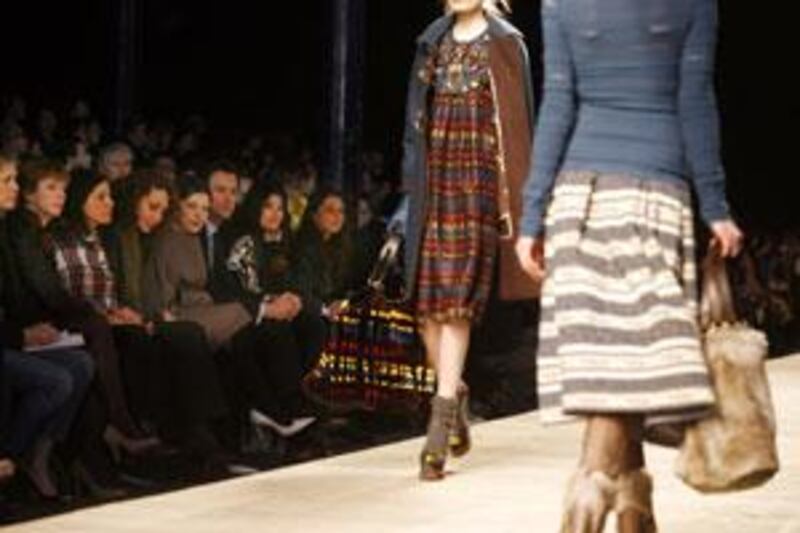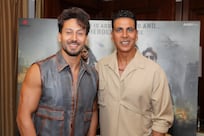So that's it for another season. The fashions of autumn/winter 2009/10 have completed their journey from mood board to the catwalk to the news report. Now we know what we'll be wearing next season - even though we've barely started to buy for spring/summer yet. But as Paris Fashion Week dies down, following some of the biggest and least typical shows of the season, the real work begins for the fashion buyers.
These are the people who really decide where fashion will go. Sitting in the front rows, notebooks and pens in hand, they judge how far their customers will take, say, the harem-pant trend, carefully calculate potential sales (none will want to be left with millions of dirhams' worth of unbought stock at next spring's sales) and put in the orders. And after all, if it ain't in the shops, the customer can't buy it.
Those last few shows may indeed have been among the most important - even if many of the cash-cautious attendees had by Tuesday left Paris - with their strongly commercial yet creative messages predicated on the fact that, whatever the economic climate, people still able to buy luxury will continue to want distinctive, imaginative and beautiful clothes. "Why would anyone want to wear the recession?" asks Zayan Ghandour, the creative director, head buyer and co-owner of Dubai and Abu Dhabi's S*uce boutiques, musing over the division between this season's safer collections and its more flamboyant ones. Her counterpart at Boutique 1 in Dubai, the head buyer Nicole Robertson, shares the same attitude: "Our customers are going for the unusual," she says. "They want the exotic, the 'wow', and they won't be playing it safe: we need to give them a reason to buy."
Certainly, after a relatively dull season, the last two days of Paris Fashion Week will have given more adventurous souls plenty to think about. Antonio Marras's show for Kenzo and John Galliano's eponymous collection were both saturated with Gypsy prints, Eastern European patterns, Russian and Mongolian shapes, and an almost Byzantine opulence, in glossy silks, rich furs and strong, warm wools. Embroidery and appliqué, ultra-feminine shapes, romantic colours and entirely wearable pieces should make these sure-fire hits with the exotica-loving shopper that Robertson speaks of.
Chloé, too, took a rustic approach, in Hannah MacGibbon's first ready-to-wear collection for the brand. Models wearing strong, masculine, caped and blanket coats, loose, belted paper bag-waisted trousers and silver-buttoned khaki shirts strode out to Kings of Leon's hillbilly anthem Knocked Up like Confederate veterans. Oversized jackets made the season's big-shoulder trend look natural, unlike some of the more contrived versions elsewhere, and the delicate, flowing, translucent frocks later in the show made an interesting contrast.
Elie Saab's collection was an ode to simplicity - a far cry from the crystal-embellished evening frocks of yore - but nevertheless each piece was a distinctive, instantly recognisable garment with none of the space-fillers that appeared on many catwalks. The figure-hugging, pale stone-coloured day dresses, whose complex and visible seaming moulded them into 1940s-style curves, were an unusual approach for Saab, and the one-sleeved, strong-shouldered dresses in peacock purple and powder blue pumped up the otherwise classic Grecian evening wear offering. Same-colour crystal embellishment (black-on-black, putty-on-putty) on bolero jackets over dramatic high-waisted tapered trousers meant that even those few moments of bling had a hard, cool look to them, and the ubiquitous long leather gloves (surely the accessory of the season) looked satisfyingly tough.
Having showed with the couture season for the last year, Roland Mouret re-emerged on the ready-to-wear circuit on Thursday in a show at the Musée de l'Homme - though the catchily titled RM by the Designer Roland Mouret collection (he lost the rights to his name when he left his former backers) was all woman, with plenty of his trademark demure curves, origami folds and edgily chic coats - a gift to buyers thanks to their combination of an "It" label and completely wearable clothing.
And it was, of course, two of the fashion world's biggest individualists who rounded off the season with their collections for luxury brands: Jean Paul Gaultier for Hermès and Marc Jacobs for Louis Vuitton. At Hermès, Gaultier concentrated on what the brand does best: leather. Shown on one of the few big, extravagant catwalk sets of the season, featuring rotating propellers and runway lights, Gaultier's aviator jackets, skirts, caps and suits in grey and tan hides with fur collars were inspired by the great American pilot Amelia Earhart. For evening, bias-cut 1930s-style liquid satin dresses sat beneath masculine coats, and models carried trompe l'oeil Birkins, on which the famous strap was embossed - a perfect example of the sort of memorable twists on classics that luxury shoppers will be looking for.
Meanwhile, Jacobs took the strongest stance against recession dressing all season, with a frothy, frivolous collection full of Moulin Rouge references and coquettish, flirty shapes, the cancan soundtrack giving us a clue to his inspiration: black lace, beribboned jackets, ruffles and rich colours in bold defiance of the season's caution. If the Dubai buyers are to be believed, this is the approach that will carry most strongly through to autumn/winter, with the more unusual and distinctive looks making the most sense in a season when shoppers may cut back on their spending.
Says Ghandour: "The designer runway collections for next winter fell into two extremes: those who went way out with flashy colours and playful shapes, making bold statements that they are not afraid of the economic recession; and those who played it safe with 'commercial' looks in a palette of blacks, dark aubergine and shades of grey. Naturally S*uce bought into colour, flash and optimism." She cites the fact that Marc Jacobs' own Eighties-inspired autumn/winter collection is full of brights as something that will continue to drive this spring/summer's sales in fluoro shades, making the transition to next season easier. "It is all about Eighties shapes, colours and attitude," she says. "Think Alexis Carrington, Punky Brewster and Jane Fonda."
Certainly, while fluoro was hard to come by, even the most notoriously monochrome collections throughout the season, such as Calvin Klein or Yohji Yamamoto, featured shots of one or two colours, whether royal blue, a rich orange or acidic mustard yellow. Many of those that didn't, including the one-time fluoro king Christopher Kane, went for strong patterns such as stripes or spots instead. But the really distinctive looks were all about shape, with silhouettes being stronger and bolder than for many years, giving the shopper something other than pretty fabric to justify their purchases. While a rich satin of course looks glamorous, there's nothing more expensive and luxurious than a beautifully cut jacket, draped, shaped and moulded, and variations on these, as well as on quirkily constructed dresses and skirts, were the stock in trade of many a designer, from Alber Elbaz at Lanvin to the hot young London-based brand Qasimi.
"The world was about ready to deem shoulder pads a thing of the past when they made their comeback," says Ghandour. "Padded shoulder jackets in royal blue or fuchsia pink will certainly become key fashion pieces. Alexander Wang has a great version in stores already. And all-in-one pantsuits are still hot but this time they come in colours." For Robertson at Boutique 1, these looks joined strong fabrics as the most important features of autumn. "The key buys of the seasons are dresses, leather and suede and jackets with strong, padded shoulders. It's kind of a return to power dressing but in a cool way, an edgy way, rather than a corporate Eighties way; quite dark with lots of embellishment. I've noticed that there is a lot of studding too, a lot of embellishment still, and the colours are still strong in the pieces that we're buying. Blumarine was all about colour - so much colour. It's going to be an easy transition from the summer, with lots of leather and crystals."
Leather styles, of course, appeared everywhere from the classic houses such as Hermès and Loewe to the fake leather leggings of Stella McCartney, whose hide-free collection also pointedly avoided the furs that so many designers have incorporated for next season. The buyers, though, while still careful of their budgets, have not just gone for the big names. For both Boutique 1 and S*uce, picking up new labels is an important part of their remit, to satisfy the demands of their novelty-loving customers.
"People are a lot more aware now in Dubai of keeping ahead with new brands. And that luxury buyer is still there, in spite of the recession," says Robertson. "We still want to pick up new names because that's what our customer wants from us, but of course you have to be careful in this climate. You can't just keep adding and adding, but we're definitely looking for the new labels: that's the way forward for us. This season we've added Preen and Chrissie Morris, who's fresh out of London and doing some great stuff, Bionda Castana, Charlotte Olympia, Jenny Packham, Naeem Khan, Joseph, 6126 and Elizabeth & James."
Ghandour, too, has picked up some interesting labels for the quirky selection at S*uce, including "the British label Mary Katranzou, whose collection of print dresses was inspired by shapes of perfume bottles." Even if you already know the likes of Preen and Jenny Packham, some of these labels will be unfamiliar, and that's because the buyers can source from a marathon trek around the hundreds of collections that never make it to the press, in the trade shows. Here, the labels that either can't or won't indulge in heinously expensive catwalk shows or have already shown in another city can attract the attention of serious fashion buyers, and this is where some of those smaller labels will be tapped.
For most of us, though, while the fashion world is tightening its belt, cutting back and reining in its excesses, it is those flashy, fabulous runway collections that will define our direction next autumn. And while we may limit our spending a little, both Robertson and Ghandour are right in saying that the most unusual looks are those that will sell. A recession is so often a time to establish a new aesthetic - punk in the Seventies, power-dressing in the early Eighties, minimalism in the Nineties. And let's face it, after this season, fashion can only get more exciting.





